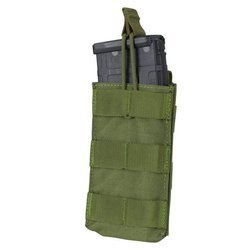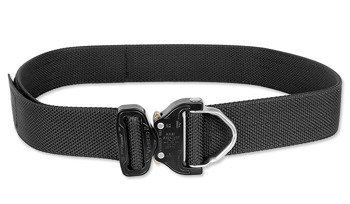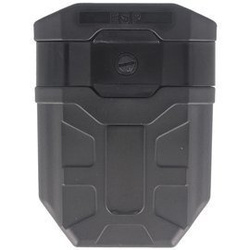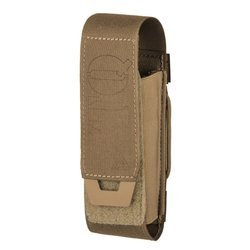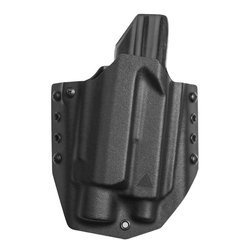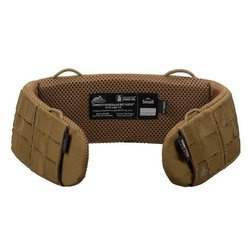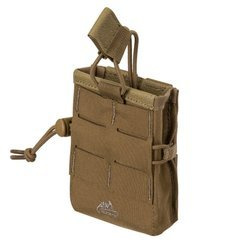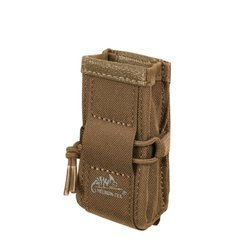Configuration of the tactical belt

We recently published a blog that briefly explains the types of belts used in general shooting. Today, however, we would like to focus on its configuration - methods of mounting accessories, their arrangement and use in itself. We will not enter here into strictly specialized models, such as, for example, configurations for IPSC based on dedicated belts. We will cover the topic in more general terms, based on a simple tactical multi-gun configuration.
A short reminder from the previous post - we mentioned that, above all, the shooting belt should be very stiff. This is necessary because it is intended to be subjected to heavy loads. In the case of the EDC belts discussed at that time, it is quite important - the compact Glock and two magazines visibly burden the belt, but the comfortable, medium-stiff model will handle it, especially as it will rather work with an inner holster, additionally stabilized by trousers.
However, in the case of tactical or sport shooting in formulas such as 3Gun, literally a lot of equipment lands on the runway. Even assuming the choice of a light service pistol, we have here, after loading, a kilogram in the holster itself, along with several 200-gram magazines. Let's add 2 or 3 AR magazines (almost half a kilo one), not to mention other platforms, and we have several kilos on the belt, from which we expect that they will not significantly hinder our work. For stability, we therefore need a suitable stiff belt that will not bend with the slightest movement.
Accessories attached to the belt
Returning, however, to the main topic - accessories. The belt itself is a "frame" supporting our equipment. However, there are various ways of mounting accessories on it, as well as fastening the belt on the user's body. Very stable, but the least ergonomic in terms of putting on and taking off, is the belt loops and the holster and pouches. In this way, we significantly limit unwanted belt movements up and down, as well as the movement of accessories - the belt loops of the trousers hold them in place quite well. However, we can forget about the quick release of the belt, which, taking into account the fact that we spend only a small part of our time on the track during the competition, is an important feature. Putting on and off the belt with accessories is also not pleasant.

However, fastening the “bare” belt with a heavy load directly to the clothes will not guarantee stability. This is where internal belts and sleeves come in handy, or sometimes both. To be able to use the inner belt, the inside of our main belt must have sewn Velcro. Then we weave the inner belt through the belt loops of the trousers, and then the main belt, equipped with a holster and pouches, is put on quickly and efficiently, fastening it with Velcro. With such a large velcro area, the main belt will stay firmly in position, while being able to be released at any time.
MOLLE sleeve for tactical shooting belts
The second stabilizing solution are the sleeves for shooting belts, most often also equipped with the MOLLE assembly system. They increase the contact area of the belt with the body, increasing comfort and absorbing shocks of the equipment. They can also be equipped with Velcro lining, allowing the use of an inner belt. When choosing the sleeve option, we must remember about an important aspect - mounting the holster to the gun. If you do not want to play with the use of MOLLE adapters, it is worth paying attention to whether it allows for some kind of modularity when buying a sleeve. Typically, this feature will manifest itself in the sectioned MOLLE overlay. It will allow at selected points to lead the belt outside, outside the sleeve, which will allow us to directly mount the holster.
However, the MOLLE system is a valuable ally, and if our belt is not equipped with sewn cells, the sleeve can be a good complement to it. Nothing will provide us with such stability of the pouches as the system of tapes and holes. Regardless of our position, the pouches will remain in the same place. However, you should remember to use the correct method of interlacing, including both tapes on the belt and on pouches. It is worth mentioning that some target shooting formulas do not allow the use of belts equipped with mounting systems cells.

In such a case, the use of a sleeve with a rigid belt may translate into greater versatility than in the case of a model with cells sewn directly on it. In formulas that do not allow the use of MOLLE, such as IPSC or IDPA, we can then only use the main belt. In tactical shooting or, for example, 3GUN, it is not possible to quickly and easily convert the belt into the MOLLE variant.
It is also worth paying attention to the economic aspect. Pouches for firearms magazines made of soft materials, which are generally dedicated to the MOLLE system, are definitely cheaper than models, for example kydex mounted directly on the belt. Of course, they have their advantages and disadvantages that justify the price, but creating a belt, if you are limited on a budget, will be much easier with the soft pouches and MOLLE system.
Arrangement of pouches on the belt - where to place pouches?
However, going directly to the configuration. Our variant was created for tactical shooting assuming the use of a PCC type rifle and a pistol. To ensure stability, we decided to choose the Bayonet Thirdline rigid belt, based on the durable AustriAlpin Cobra 18 kN buckle and double-stitched polyamide Pasamon tape. As for the holster, the choice fell on the Direct Action OWB Light Holster model due to the flashlight mounted on the gun. The magazine pouches used are the soft Competiton Rapid Pouch by Helikon in the case of the pistol and the rigid polymer Roto type pouches for the Scorpion EVO 3 magazines. In the configuration, we also used a compact drop bag and a soft tactical tourniquet pouch from Direct Action. Thanks to the use of the Competition Modular Belt Sleeve, we were able to stably mount the MOLLE accessories, while the rigid holster and pouches directly on the belt. As a result, we have obtained a stable, comfortable tactical belt with a comfortable, even weight distribution on the hips.
OWB Kydex outer holster
The holster in this case was made of Kydex, which is currently one of the preferred materials for this type of application. It guarantees us mechanical resistance, adequate flexibility, and therefore good retention (this, of course, also depends on the method of making the holster). Its pleasant aesthetics cannot be denied either. It is worth noting here that in addition to the classic belt loop attached on the sides, the holster is also equipped with Safariland standard connectors, allowing it to be attached to a dedicated mount. Using the previously mentioned modularity of the external belt, the holster was placed on the removed segment of the main belt at four o'clock, which, combined with its angle of inclination, makes the weapon easy to draw.

At two and eight o'clock, also directly on the belt, we placed rigid polymer pouches for long gun magazines. ESP pouches equipped with the Roto system allow you to adjust the angle of the holster in the range of 360 degrees. It is a great help, especially when the pouches are located at a point with access difficult due to human anatomy. However, setting a given angle is a matter of personal preference only - we just wanted to point out here that it is possible. What is important, however, is the procedure we applied on the left side of the belt, namely placing the pouch with magazines for long weapons behind those of the pistol, which will be discussed in a moment. This solution has one simple reason - the rear position is less accessible and more difficult to see in the event of a problem. Therefore, it is easier to operate on larger elements - in this case magazines. Pouches on the front of the right side have been placed there for optimal use of functionality. Similarly, here it will be easier for us to draw a magazine from a pocket located at an angle than to bend a hand at the wrist, trying to pull out a short, vertically located pistol magazine.
Magazine dump pouch
The drop bag is placed in the almost rearward position (five or seven o'clock), on the side of the non-dominant hand, which allows us to place the used magazines in it freely. Drop bags are large enough that they do not need convenient direct contact to place a magazine in them. It is worth remembering not to put them directly at seven o'clock - this will limit the convenient access to the drop and may have unpleasant consequences during a fall or forced transition to a sitting position. In the case of shooting sports, you can sometimes meet people holding the bag at the front of the belt. This is useful in quickly recovering not fully emptied magazines in case you run out of ammunition. However, in the case of tactical applications, this solution will not work well - in a situation, for example, in a situation where you quickly fall to the ground, this type of solution will definitely limit your comfort.

Torniquet - where to mount it?
Symmetrically, at six o'clock, we recommend placing a pouch on a tactical tourniquet, or possibly a tear-off kit, if you have one. The probability that we will use it is much lower than the rest of the equipment, but it is always worth having it for preventive purposes. Correctly used tourniquet can save our lives or that of others in the event of severe external bleeding, such as a shooting. Among the handles for the tourniquet you will find versions such as the one presented - Corduroy, lighter, made of only elastic tape or Kydex. For tactical applications, it is worth considering the soft versions - lower risk of pain when falling. If, on the other hand, we want to use the first aid kit placed in this place, it is worth having a model that can be completely torn off or with a removable internal organizer. This will make it much easier for us to access the accessories we need in a stressful situation.

Outdoor accessory belt
An interesting phenomenon is the increasing use of structures related to tactical belts in outdoor applications. Easy access to accessories is also useful in the field. So why not use the belt you already have in this application? First of all, it is worth remembering that MOLLE pouches are not only pouches for magazines. We also have many cargo models, and therefore universal structures that allow you to accommodate many accessories. Pockets dedicated to navigation devices or radiotelephones can also fit perfectly on the belt - both accessories are useful for both tactical and off-road applications. A drop bag can also prove useful in the field. Collecting birch bark for kindling, quick rejection of gloves or temporarily unnecessary tools - the bag on the back of the belt will be perfect for such applications. If, on the other hand, we do not have a shooting belt by default and you just want to build an outdoor belt from scratch, we recommend choosing a slightly softer belt. It will be a bit more convenient solution, or rather, we will not be able to burden the belt to destabilize it as easily as in the case of magazines full of ammunition.

The Polish manufacturer of tactical and outdoor equipment Helikon-Tex, having experience in creating both, created pouches dedicated to outdoor belts as part of the latest Bushcraft products. The pockets have been selected to be compatible with the most important accessories used in the field - compasses, water bottles, survival accessories - everything we will need the most. Cordura compass pocket will allow for quick access and, at the same time, adequate protection of the more sensitive equipment. The Water Cantene pocket, being compatible with a standard Nalgene bottle, will allow us to leave the camp for longer, without having to take a backpack with us. A throwing bag adapted to bushcraft applications has a slightly different geometry and a smaller volume, while the SERE pocket will allow us to accommodate all the most necessary survival accessories.

